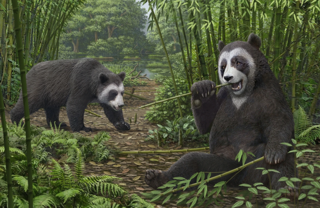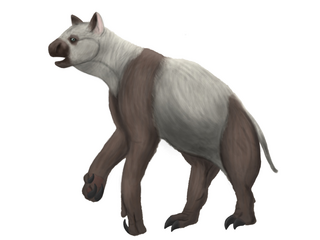
The giant panda, also known as the panda bear or simply panda, is a bear species endemic to China. It is characterised by its bold black-and-white coat and rotund body. The name "giant panda" is sometimes used to distinguish it from the red panda, a neighboring musteloid. Adult individuals average 100 to 115 kg, and are typically 1.2 to 1.9 m long. The species is sexually dimorphic, as males are typically 10 to 20% larger. The fur is white, with black patches around the eyes, ears, legs and shoulders. A thumb is visible on the bear's forepaw, which helps in holding bamboo in place for feeding. Giant pandas have adapted larger molars and expanded temporal fossa to meet their dietary requirements.

Dicerorhinus is a genus of the family Rhinocerotidae, consisting of a single extant species, the two-horned Sumatran rhinoceros, and several extinct species. The genus likely originated in the Mid to Late Pliocene of Northern Indochina and South China. Many species previously placed in this genus probably belong elsewhere.

The Qinling or Qin Mountains, formerly known as the Nanshan, are a major east–west mountain range in southern Shaanxi Province, China. The mountains mark the divide between the drainage basins of the Yangtze and Yellow River systems, providing a natural boundary between North and South China and support a huge variety of plant and wildlife, some of which is found nowhere else on earth.

Gigantopithecus is an extinct genus of ape that lived in southern China from 2 million to approximately 300-200,000 years ago during the Early to Middle Pleistocene, represented by one species, Gigantopithecus blacki. Potential identifications have also been made in Thailand, Vietnam, and Indonesia. The first remains of Gigantopithecus, two third molar teeth, were identified in a drugstore by anthropologist Ralph von Koenigswald in 1935, who subsequently described the ape. In 1956, the first mandible and more than 1,000 teeth were found in Liucheng, and numerous more remains have since been found in at least 16 sites. Only teeth and four mandibles are known currently, and other skeletal elements were likely consumed by porcupines before they could fossilise. Gigantopithecus was once argued to be a hominin, a member of the human line, but it is now thought to be closely allied with orangutans, classified in the subfamily Ponginae.

Hyaenodon ("hyena-tooth") is an extinct genus of carnivorous placental mammals from extinct tribe Hyaenodontini within extinct subfamily Hyaenodontinae, that lived in Eurasia and North America from the middle Eocene, throughout the Oligocene, to the early Miocene.

The complex-toothed flying squirrel occurs in the southern Chinese provinces Hubei, Hunan, Guizhou, Sichuan, and Yunnan. The common name refers to the teeth, which differ from those of other species of flying squirrels.

Ailuropodinae is a subfamily of Ursidae that contains only one extant species, the giant panda of China. The fossil record of this group has shown that various species of pandas were more widespread across the Holarctic, with species found in places such as Europe, much of Asia and even North America. The earliest pandas were not unlike other modern bear species in that they had an omnivorous diet but by around 2.4 million years ago, pandas have evolved to be more herbivorous.

Ailuropoda microta is the earliest known ancestor of the giant panda. It measured 1 m (3 ft) in length; the modern giant panda grows to a size in excess of 1.5 m (5 ft). Wear patterns on its teeth suggest it lived on a diet of bamboo, the primary food of the giant panda. The first discovered skull of the animal in a south China limestone cave is estimated to be 2 million years old. The skull found is about half the size of a modern-day giant panda, but is anatomically very similar. This research suggests that the giant panda has evolved for more than 3 million years as a completely separate lineage from that of other bears.

Wushan Man is a set of fossilised remains of an extinct, undetermined non-hominin ape found in central China in 1985. The remains are dated to around 2 million years ago and were originally considered to represent a subspecies of Homo erectus.

Ailurarctos is an extinct genus of panda from the Late Miocene of China, some 8 million years ago.

Tillodontia is an extinct suborder of eutherian mammals known from the Early Paleocene to Late Eocene of China, the Late Paleocene to Middle Eocene of North America where they display their maximum species diversity, the Middle Eocene of Pakistan, and the Early Eocene of Europe. Leaving no descendants, they are most closely related to the pantodonts, another extinct group. The tillodonts were medium- to large-sized animals that probably feed on roots and tubers in temperate to subtropical habitats.

Ursavini is an extinct tribe of mammals of the family Ursidae (bears) endemic to North America, Europe, Africa, and Asia during the Miocene through the Pliocene, living from about 23—2.5 Mya, existing for roughly 20.5 million years.

Simosthenurus occidentalis is a species of sthenurine marsupial that existed in Australia during the Pliocene, becoming extinct in the Pleistocene epoch around 42 000 years ago. A large herbivorous biped that resembles large kangaroos, the species had a heavier body than the modern roo. The structure of the skull and teeth indicates it consumed tough vegetation, resembling koalas and panda bears, and is referred to as a short-faced kangaroo.

Ailuropoda baconi is an extinct panda known from cave deposits in south China, Laos, Vietnam, Myanmar and Thailand from the Late Pleistocene, 750 thousand years ago, and was preceded by A. wulingshanensis and A. microta as an ancestor of the giant panda. Very little is known about this animal; however, its latest fossils have been dated to the Late Pleistocene.
This paleomammalogy list records new fossil mammal taxa that were described during the year 2011, as well as notes other significant paleomammalogy discoveries and events which occurred during that year.

Agriotheriini is an extinct tribe of ailuropodine bears from the Middle Neogene to Early Quaternary periods with fossils found from Eurasia, Africa and North America. The tribe consists of the genera Agriotherium, Huracan, Indarctos, and possibly Miomaci. The taxonomy of these bears has variously placed some of the genera in other bear lineages such as Hemicyoninae and Ursavinae.

Mo (貘) was the standard Chinese name for the giant panda from the 3rd century BCE to the 19th century CE, but in 1824, the French sinologist Jean-Pierre Abel-Rémusat mistakenly identified the mo as the recently discovered black-and-white Malayan tapir, which never inhabited China in historical times. He based this misidentification on Chinese woodblock illustrations that depicted a mythological mo (貘) chimera with elephant trunk, rhinoceros eyes, cow tail and tiger paws, which the famous Tang poet Bai/Bo Juyi first described in the 9th century. The consequences of Abel-Rémusat's error were extensive. His presumption that mo meant "Chinese tapir" was immediately adopted in Western zoology, and by the end of the 19th century, it was accepted as modern scientific fact in China and Japan. In the 20th century, since mo had lost its original meaning, the giant panda was given a new Chinese name da xiongmao.

Hualong Cave is a cave in Pangwang village in Dongzhi County, Anhui Province, China, and situated on the southern bank of Yangtze. It is located on the side of Meiyuan Hill. Palaeontological interest started in 2004 when a farmer accidentally found bones that were later identified as mammalian fossils. Excavations started in 2006 by paleontologists from the Chinese Academy of Sciences. It has yielded many stone tools and over 30 human fossils, and animal bones including those of Ailuropoda, Arctonyx, Bubalus, Sinomegaceros, Stegodon, giant tapir, and giant pandas. The most notable fossils are those of the Hualongdong people, including Homo erectus described in 2014, and that of a 300,000-year-old archaic human discovered in 2019.

Hesperotherium is a genus of chalicotheres from the Early to Middle Pleistocene of China. Along with Nestoritherium, it was one of the last of the chalicotheres to ever exist. It belonged to the subfamily Chalicotheriinae, which also includes Anisodon, Chalicotherium and Nestoritherium.
Huracan is an extinct genus of agriotheriin ailuropodine from the Neogene period. Fossils were found from North America and Eastern Asia. Unlike its modern relative the giant panda, which is a bamboo specialist, Huracan was a hypercarnivorous genus of bear that had adaptations for cursoriality.




















